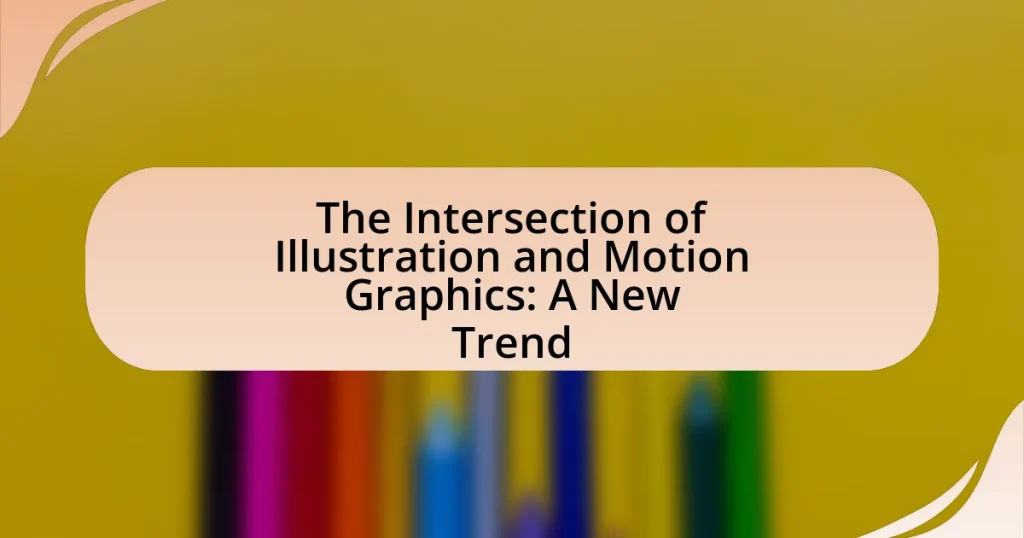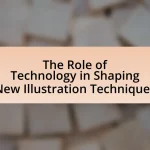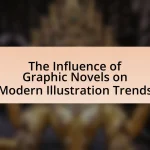The article explores the intersection of illustration and motion graphics, highlighting how the integration of static visual art with animated elements enhances storytelling and audience engagement. It discusses the complementary nature of these two mediums, emphasizing key elements such as visual storytelling, character design, and animation techniques. The article also examines the growing trend driven by technological advancements and cultural demands for engaging visual content, particularly in advertising, education, and entertainment. Additionally, it outlines best practices for creating effective illustrations in motion graphics, essential skills for artists, and resources for learning these techniques.
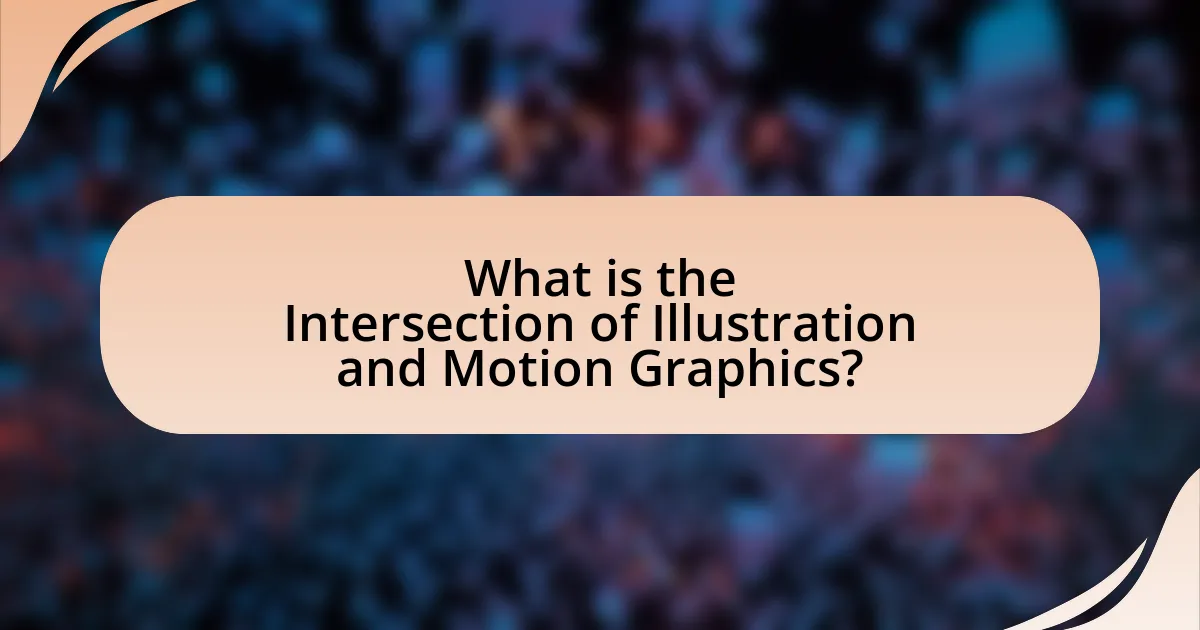
What is the Intersection of Illustration and Motion Graphics?
The intersection of illustration and motion graphics is the integration of static visual art with animated elements to create dynamic storytelling experiences. This fusion allows illustrators to enhance their artwork through movement, adding depth and engagement that static illustrations cannot achieve. For instance, animated infographics combine illustrative design with motion to convey complex information more effectively, as seen in various digital marketing campaigns. This trend is increasingly prevalent in advertising, social media, and educational content, where visual storytelling is essential for capturing audience attention and conveying messages succinctly.
How do illustration and motion graphics complement each other?
Illustration and motion graphics complement each other by enhancing visual storytelling through dynamic movement and engaging imagery. Illustrations provide a unique artistic style and character, while motion graphics add life and context, making the content more captivating. For instance, a static illustration can convey a concept, but when animated, it can demonstrate processes or evoke emotions more effectively, as seen in marketing campaigns where animated illustrations increase viewer retention by up to 80%. This synergy allows creators to communicate complex ideas in a more accessible and visually appealing manner, ultimately enriching the audience’s experience.
What are the key elements of illustration in motion graphics?
The key elements of illustration in motion graphics include visual storytelling, character design, color theory, and animation techniques. Visual storytelling is essential as it conveys narratives through imagery, engaging the audience effectively. Character design focuses on creating relatable and memorable figures that enhance the narrative. Color theory plays a crucial role in setting the mood and tone, influencing audience emotions and perceptions. Animation techniques, such as timing and movement, bring illustrations to life, creating dynamic visual experiences. These elements collectively contribute to the effectiveness and appeal of motion graphics in communicating ideas and messages.
How does motion enhance traditional illustration techniques?
Motion enhances traditional illustration techniques by adding depth and interactivity, which engages viewers more effectively. The incorporation of motion allows static illustrations to convey narratives and emotions that are difficult to express in a still format. For instance, animated illustrations can demonstrate processes or transformations, making complex ideas more accessible. Research indicates that visual content with motion increases retention rates by up to 80%, as it captures attention and stimulates cognitive engagement. This synergy between motion and traditional illustration not only modernizes the art form but also broadens its application in fields such as advertising, education, and entertainment.
Why is this intersection becoming a new trend?
The intersection of illustration and motion graphics is becoming a new trend due to the increasing demand for engaging visual content in digital media. This trend is driven by the rise of social media platforms and the need for brands to capture audience attention quickly. According to a report by HubSpot, 54% of consumers prefer to see video content from brands they support, highlighting the effectiveness of motion graphics in storytelling. Additionally, advancements in technology have made it easier for artists to combine static illustrations with dynamic animations, resulting in visually compelling narratives that enhance user experience.
What cultural or technological factors are driving this trend?
Cultural factors driving the trend of illustration and motion graphics include the increasing demand for visually engaging content in digital media, influenced by social media platforms that prioritize eye-catching visuals. Technological factors include advancements in software and tools that facilitate the creation of dynamic illustrations and animations, such as Adobe After Effects and Procreate, which have made it easier for artists to blend traditional illustration techniques with modern motion graphics. The rise of mobile devices and high-speed internet has also enabled broader access to animated content, further fueling this trend.
How are audiences responding to the combination of these two mediums?
Audiences are responding positively to the combination of illustration and motion graphics, appreciating the enhanced storytelling and visual engagement it offers. This fusion creates dynamic content that captures attention more effectively than static images alone, leading to increased viewer retention and emotional connection. Research indicates that 70% of consumers prefer video content over static content, highlighting the effectiveness of motion graphics in conveying messages. Furthermore, platforms like Instagram and TikTok have seen a surge in engagement rates for posts that utilize animated illustrations, demonstrating audience preference for this innovative blend.
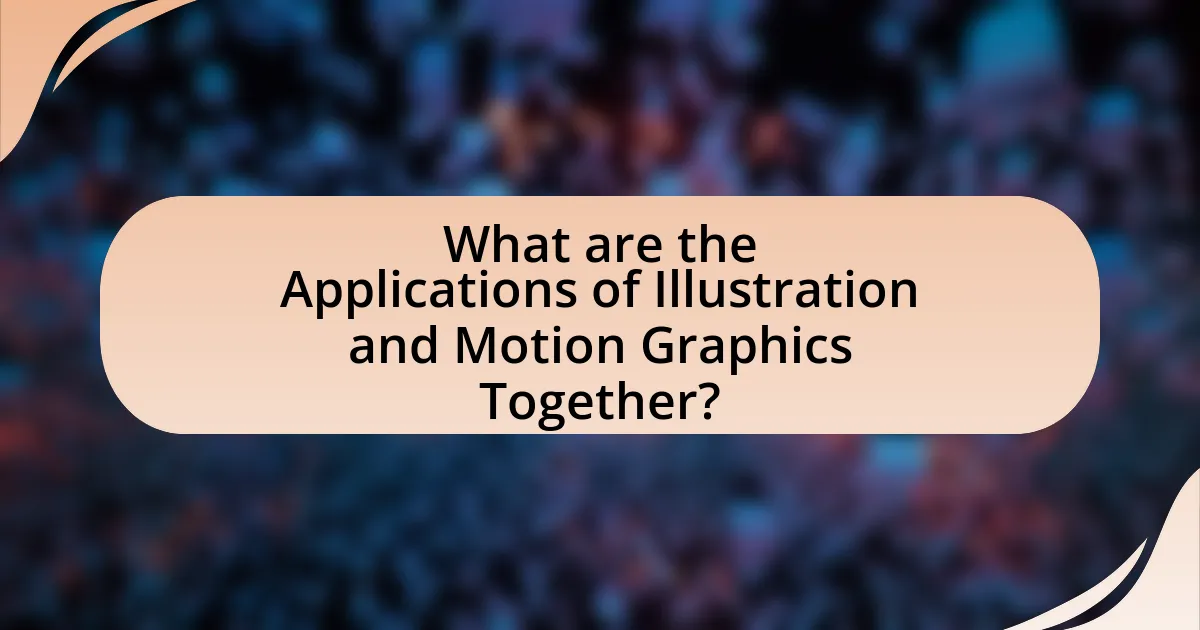
What are the Applications of Illustration and Motion Graphics Together?
The applications of illustration and motion graphics together include enhancing storytelling in advertising, creating engaging educational content, and improving user experience in digital interfaces. In advertising, brands utilize animated illustrations to capture attention and convey messages more effectively, as seen in campaigns by companies like Apple and Nike, which leverage dynamic visuals to create memorable narratives. In education, platforms like Khan Academy use animated illustrations to simplify complex concepts, making learning more accessible and engaging for students. Additionally, in user interface design, animated illustrations can guide users through processes, improving navigation and interaction, as demonstrated by apps that incorporate animated tutorials to enhance usability.
In which industries is this trend most prevalent?
The trend of integrating illustration and motion graphics is most prevalent in the advertising and marketing industries. These sectors utilize animated illustrations to create engaging content that captures audience attention and enhances brand storytelling. According to a report by HubSpot, 54% of consumers prefer to see video content from brands they support, highlighting the effectiveness of motion graphics in marketing strategies. Additionally, the entertainment industry employs this trend extensively in animated films and video games, where visual storytelling is crucial for audience engagement.
How is the advertising industry utilizing this intersection?
The advertising industry is utilizing the intersection of illustration and motion graphics to create engaging and visually dynamic content that captures audience attention. By combining static illustrations with animated elements, brands enhance storytelling and convey messages more effectively, leading to higher engagement rates. For instance, a study by Wyzowl in 2022 found that 86% of businesses reported using video as a marketing tool, with animated content being particularly effective in increasing viewer retention and brand recall. This trend reflects a shift towards more creative and interactive advertising strategies that leverage the strengths of both mediums.
What role does this trend play in the entertainment sector?
The trend of integrating illustration and motion graphics plays a significant role in the entertainment sector by enhancing visual storytelling and audience engagement. This combination allows creators to produce dynamic content that captures attention more effectively than static images alone. For instance, animated illustrations can convey complex narratives in a more accessible manner, as seen in popular animated series and films that utilize this technique to attract diverse audiences. Furthermore, according to a report by Adobe, 80% of consumers are more likely to engage with content that incorporates motion graphics, highlighting its effectiveness in marketing and promotional materials within the entertainment industry.
What are the benefits of combining illustration and motion graphics?
Combining illustration and motion graphics enhances visual storytelling by creating dynamic and engaging content. This synergy allows for the conveyance of complex ideas in a simplified manner, making information more accessible and memorable. For instance, studies show that visuals can increase retention rates by up to 65% compared to text alone. Additionally, the combination fosters creativity, enabling artists to explore new dimensions and styles, which can lead to innovative marketing strategies and improved audience engagement.
How does this combination enhance storytelling?
The combination of illustration and motion graphics enhances storytelling by creating a dynamic visual narrative that captures audience attention and conveys complex ideas more effectively. This synergy allows for the integration of artistic expression with movement, making stories more engaging and memorable. For instance, studies show that visual storytelling can increase information retention by up to 65% compared to text alone, demonstrating the power of combining these mediums to enhance comprehension and emotional impact.
What advantages does it offer in terms of audience engagement?
The intersection of illustration and motion graphics offers significant advantages in terms of audience engagement by creating visually dynamic content that captures attention more effectively than static images. This combination enhances storytelling, allowing for a more immersive experience that can evoke emotions and maintain viewer interest. Research indicates that motion graphics can increase viewer retention by up to 95% compared to traditional media, demonstrating their effectiveness in engaging audiences.
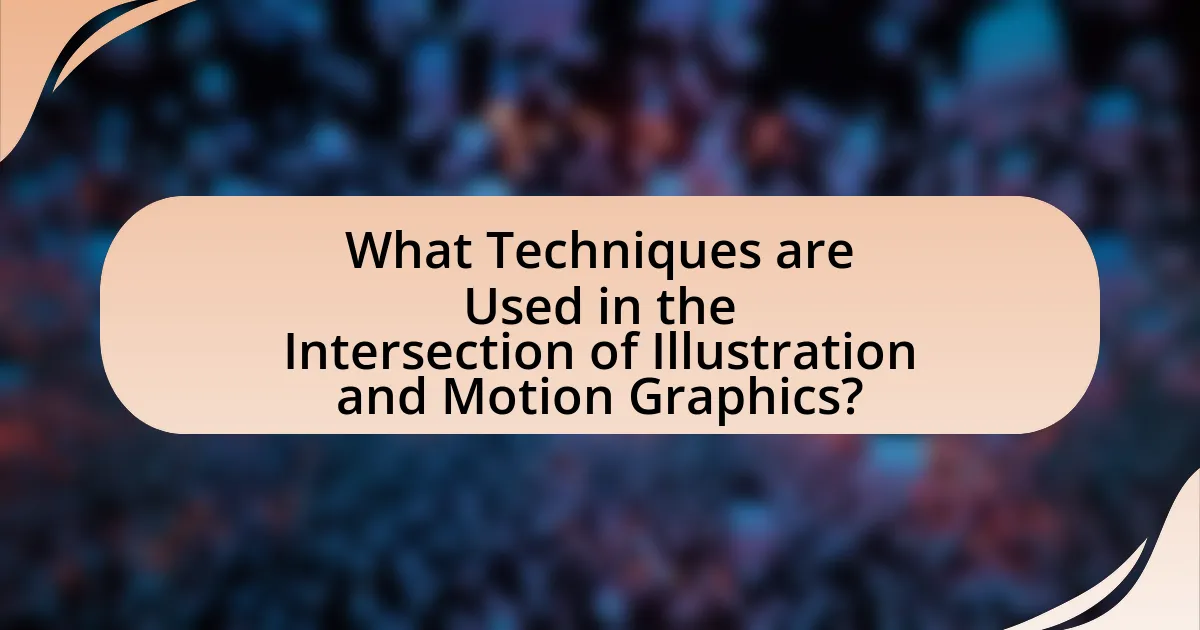
What Techniques are Used in the Intersection of Illustration and Motion Graphics?
Techniques used in the intersection of illustration and motion graphics include frame-by-frame animation, vector animation, and 3D modeling. Frame-by-frame animation involves creating individual frames to produce fluid motion, commonly seen in traditional animation styles. Vector animation utilizes scalable graphics, allowing for smooth transitions and movements without loss of quality, often employed in software like Adobe After Effects. 3D modeling adds depth and realism, enabling illustrators to create immersive environments and characters that can be animated in three dimensions. These techniques are validated by their widespread application in various media, including advertising, film, and digital content, demonstrating their effectiveness in engaging audiences.
What software tools are commonly used for this combination?
Common software tools used for the combination of illustration and motion graphics include Adobe After Effects, Adobe Illustrator, and Blender. Adobe After Effects is widely recognized for its powerful animation capabilities, allowing illustrators to create dynamic motion graphics. Adobe Illustrator serves as a primary tool for creating vector illustrations, which can then be animated in After Effects. Blender, an open-source 3D creation suite, is also utilized for integrating 3D elements into motion graphics, enhancing the visual storytelling aspect. These tools are essential in the industry, as they provide the necessary features for blending static illustrations with animated elements effectively.
How do these tools facilitate the creative process?
These tools facilitate the creative process by streamlining workflows and enhancing collaboration among artists. For instance, software like Adobe After Effects allows illustrators to animate their designs seamlessly, reducing the time spent on manual tasks and enabling rapid iteration. Additionally, platforms such as Figma promote real-time collaboration, allowing multiple creators to contribute and refine ideas simultaneously, which fosters innovation and creativity. Research indicates that tools that enhance collaboration can lead to a 20% increase in project efficiency, demonstrating their effectiveness in facilitating the creative process.
What skills are essential for artists working in this field?
Artists working in the intersection of illustration and motion graphics require a blend of technical and creative skills. Essential skills include proficiency in digital illustration software such as Adobe Illustrator and Photoshop, as well as animation tools like Adobe After Effects and Blender. These tools enable artists to create visually compelling graphics that can be animated effectively. Additionally, a strong understanding of design principles, including composition, color theory, and typography, is crucial for producing aesthetically pleasing work. Knowledge of storytelling techniques enhances the ability to convey messages through motion graphics. Furthermore, familiarity with current trends in both illustration and animation helps artists stay relevant in a rapidly evolving field.
What are some best practices for creating effective illustrations in motion graphics?
Effective illustrations in motion graphics should prioritize clarity, simplicity, and visual storytelling. Clarity ensures that the audience easily understands the message being conveyed, while simplicity helps avoid overwhelming viewers with excessive details. Visual storytelling engages the audience by creating a narrative that guides them through the content.
Additionally, using a consistent color palette and style enhances brand recognition and visual coherence. Research indicates that consistent visual elements can improve viewer retention by up to 80%. Incorporating movement that complements the illustration, rather than distracts from it, is crucial; animations should enhance the narrative flow.
Finally, testing illustrations with target audiences can provide valuable feedback, ensuring that the visuals resonate effectively. Studies show that user testing can increase the effectiveness of visual communication by identifying areas for improvement.
How can artists ensure their work is visually cohesive?
Artists can ensure their work is visually cohesive by establishing a consistent color palette, style, and thematic elements throughout their pieces. Consistency in color helps create a unified look, as seen in successful projects where a limited color scheme enhances visual harmony. Additionally, maintaining a similar artistic style, whether through line quality, texture, or form, reinforces the overall aesthetic. Thematic elements, such as recurring motifs or concepts, further bind the work together, making it recognizable and coherent. Research indicates that visual coherence can significantly impact audience perception and engagement, as cohesive works are often more appealing and easier to understand.
What common pitfalls should creators avoid?
Creators should avoid the pitfalls of neglecting audience engagement, overcomplicating designs, and failing to adapt to technological advancements. Neglecting audience engagement can lead to a disconnect between the creator’s work and the viewers’ interests, resulting in lower impact and reach. Overcomplicating designs can overwhelm the audience, making the message unclear; simplicity often enhances understanding and retention. Failing to adapt to technological advancements, such as new software or trends in motion graphics, can render a creator’s work outdated, as the industry is rapidly evolving. These pitfalls can significantly hinder a creator’s success in the competitive landscape of illustration and motion graphics.
How can one get started in this field?
To get started in the field of illustration and motion graphics, one should begin by acquiring foundational skills in both traditional illustration techniques and digital animation software. Learning programs such as Adobe After Effects and Illustrator is essential, as they are industry standards for creating motion graphics and illustrations.
Engaging in online courses or tutorials can provide structured learning, while practicing by creating personal projects helps in building a portfolio. According to a survey by the Bureau of Labor Statistics, proficiency in software tools significantly enhances job prospects in creative fields, indicating that technical skills are crucial for success. Networking with professionals in the industry through platforms like LinkedIn or attending workshops can also provide valuable insights and opportunities.
What resources are available for learning these techniques?
Online platforms such as Skillshare, Udemy, and Coursera offer a variety of courses specifically focused on illustration and motion graphics techniques. These platforms provide structured learning paths, video tutorials, and projects that enhance practical skills. For instance, Skillshare features courses like “Animation for Illustration” by Andrew Hochradel, which combines both disciplines effectively. Additionally, Adobe offers official tutorials on their website for software like After Effects and Illustrator, which are essential tools in this field. These resources are widely recognized for their quality and relevance, making them valuable for anyone looking to learn these techniques.
How can aspiring artists build a portfolio that showcases this intersection?
Aspiring artists can build a portfolio that showcases the intersection of illustration and motion graphics by integrating both static and animated works that highlight their skills in both areas. They should create a diverse range of pieces that include illustrated characters, scenes, and elements that are then animated to demonstrate movement and storytelling. This approach not only displays their artistic versatility but also aligns with industry trends where dynamic visuals are increasingly in demand.
For instance, according to a report by Adobe, 87% of creative professionals believe that motion graphics enhance the storytelling aspect of visual content, making it more engaging. By including projects that blend these two disciplines, such as animated illustrations or GIFs, artists can effectively attract potential clients and employers looking for innovative visual solutions.
